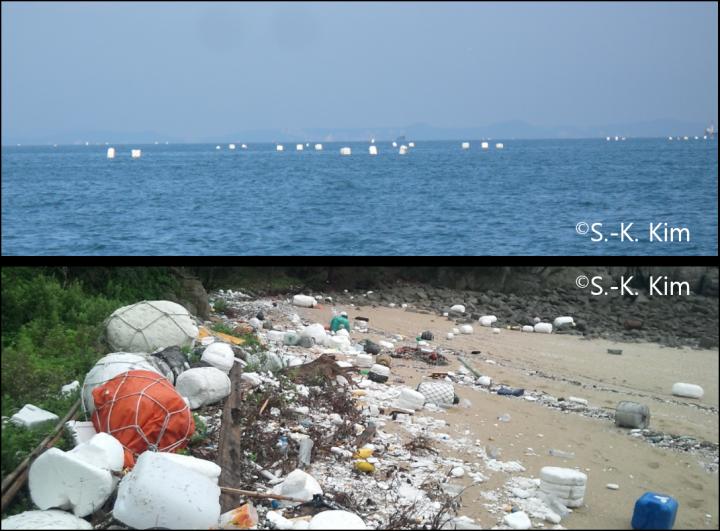Scientists provide improved method to estimate public exposure to hazardous micropollutants from plastic waste

Credit: Seung-Kyu Kim from Incheon National University
Plastic pollution has been at the center of environmental debate for decades. While it is well-known that plastic in the environment can break down into microplastics, be ingested by humans and other organisms, transfer up the food chain, and cause harm, this is only one part of the picture. Plastics are almost always enriched with additives, which makes them easier to process, more resistant, or more performant. This poses a second problem: when the polymer material is left in an environment for long durations, these additives can easily leach out and contaminate the environment.
This is the case with styrene oligomers (SOs), a type of plastic additive commonly found in polystyrene, which have been causing growing concern due to their effects on hormonal disruption and thyroid function. Authorities usually rely on scientists’ risk assessments to evaluate such public hazards and determine the appropriate action to minimize their impact. But scientists struggle to accurately measure the proportion of leachable plastic additives (i.e., the bioavailable fraction), as it is difficult to discriminate between leached compounds and those still bound to the source plastic material. Adding to the problem is the fact that these additives can diffuse into the environment at different rates.
Now, in a new study, Prof. Seung-Kyu Kim from Incheon National University, Korea, and his team have come up with an assessment method that could change the game. Their findings are published in Journal of Hazardous Materials.
Prof. Kim and his team collected surface sediments from an artificial lake connected to the Yellow Sea, with several potential sources of SO pollution from the surrounding land area and from marine buoys. “We were hoping that the distribution of SO contaminants in the lake’s sediments would help identify their most likely source and measure the leachable amount from the source material,” Prof. Kim explains. The scientists also examined one of these potential sources by dissecting a locally-used polystyrene buoy, measuring the concentration of SOs in it and how much leached out of it.
A key finding from their investigation was that SO dimers (SDs) and trimers (STs) dilute in water at different rates, so their composition in coastal sediments is very different from what can be observed in the buoys and other potential sources. This was especially true for STs: heavy, hydrophobic molecules that tended to remain in the source microplastics and moved at a slower rate in the lake. The lighter SD molecules leached out much more readily and traveled further. This meant that the SD to ST ratio would increase further away from the source of the contaminant.
Based on this dynamic, the researchers suggest using this ratio as a “reference index” to identify the source of SOs and to estimate the bioavailable fraction of SOs in a given sample. In Prof. Kim’s words, this would “be critically important to the assessment of ecological and human risk caused by plastic additives”, enabling more accurate risk assessments for potential exposure, and perhaps, formulating policies for disallowing certain more leachable, and therefore more hazardous, additives.
###
Reference
Authors: Zhexi Tiana (1), Seung-Kyu Kim (1,2), Jung-Ho Hyun (3)
Title of original paper: Environmental Distribution of Styrene Oligomers (SOs) Coupled with Their Source Characteristics: Tracing the Origin of SOs in the Environment
Journal: Journal of Hazardous Materials
DOI: https:/
Affiliations:
(1) Department of Marine Science, College of Natural Sciences, Incheon National University
(2) Institute of Basic Science, Incheon National University
(3) Department of Marine Science and Convergence Technology, Hanyang University
About Incheon National University
Incheon National University (INU) is a comprehensive, student-focused university. It was founded in 1979 and given university status in 1988. One of the largest universities in South Korea, it houses nearly 14,000 students and 500 faculty members. In 2010, INU merged with Incheon City College to expand capacity and open more curricula. With its commitment to academic excellence and an unrelenting devotion to innovative research, INU offers its students real-world internship experiences. INU not only focuses on studying and learning but also strives to provide a supportive environment for students to follow their passion, grow, and, as their slogan says, be INspired.
Website: http://www.
About the author
Professor Seung-Kyu Kim received a BS in Oceanography, as well as a MS and a PhD in Environmental Chemistry from Seoul National University in Korea. He is an environmental chemist interested in the environmental fate and transport of environmental pollutants, as well as assessing their human and ecological effects. Over the past few years, his team has assessed the behavior, distribution, budget, and exposure of microplastics (MPs) and their associated chemicals from freshwater systems to the open ocean (including in polar regions). Their research goal is to determine their mass flows on a regional and global scale, including lab-based and field-based studies (terrestrial environment, coastal region, marginal seas, open ocean, and Arctic/Antarctic region) and multiple compartments (air, water, soil, ice/snow, and biota).
Media Contact
Seung-Kyu Kim
[email protected]
Original Source
http://www.
Related Journal Article
http://dx.




